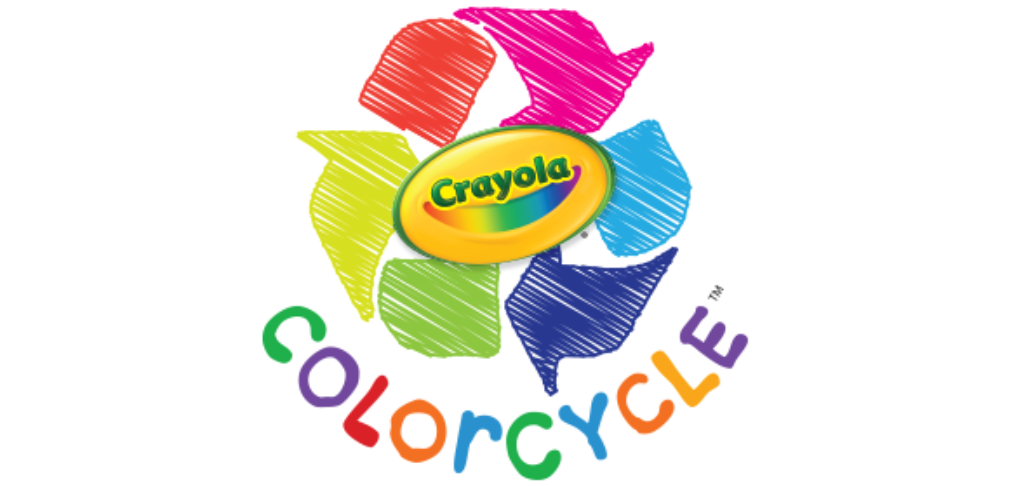
ColorCycle by Crayola
DON’T CHUCK THOSE MARKERS.
15 pounds of dead markers that will NOT end up in landfills or our oceans. Did you know that Crayola has a program called ColorCycle? Crayola ColorCycle will accept all brands of plastic markers, not just Crayola markers. That includes dry erase markers & highlighters. If you collect the dead markers, they’ll send you a free shipping label & you can ship them back to Crayola to be recycled!
Crayola and schools across North America are banding together to help kids understand the importance of their role in protecting the environment. That’s why we launched Crayola ColorCycle. Through this initiative, students in K-12 schools across the continental United States and parts of Canada can collect and repurpose used Crayola markers.
ColorCycle is also a great opportunity for teachers and their students to explore eco-friendly practices. Specially developed standards-based lesson plans are available to enrich instruction and promote lively class discussions.
Link to get started with this program:
4 Easy Steps to an Eco-Cool School!
Participating in ColorCycle with your school is as easy as 1-2-3-4!

Engage & Educate
Inform your school administrators or PTO about participating in the ColorCycle program.

Collect & Count
Set up a collection station in your school for used markers. Count up all the markers.

Pack & Print
Pack markers in a cardboard box (with minimal outer markings). Print out a shipping label.

Ship & Smile
FedEx Ground will pick up the markers — Crayola pays all shipping charges! Finally, smile – you just saved the planet! Get Started here!
https://www.crayola.com/colorcycle/sign-in.aspx
http://www.crayola.com/colorcycle.aspx
This program is currently in the US & parts of Canada, check website & www.crayola.com/colorcycle/frequently-asked-questions.aspx – FAQ.
Kids get so excited to set up boxes at their schools…know any teachers? These markers were collected in just 3 months at a preschool! Imagine what we could divert from landfills during the whole school year at every school!
Kindly Share! Thank you!




I have 36 dried out markers that I would like to send to color cycle. Can you please send me the information on how to do that?
Thank you.
Crayola ended that program…too much money and nobody could recycle the tiny parts involved.
This is a worthy gesture, but I think we all imagine the markers will magically disappear once they reach Crayola. What happens to them after they get to you? Are any of the materials that go into the markers re-used? Since plastic can only be broken down into microplastics but never destroyed, what happens to the markers’ plastic shells?
Could you please send me the address for sending dried out markers to
Why aren’t the above 2 comments being answered? I’m curious also.
Q9. Is your carbon footprint really being reduced as a result of the ColorCycle program?
A. Crayola always looks to reduce its carbon footprint. For example, we track CO2e for all of our North American operations, set goals to improve, track our progress, and make the information public on http://www.crayola.com.
Q11. Does Crayola receive any money for participating in this process?
A. No, Crayola does not receive money from participating in the ColorCycle program.
Q12. Who is eligible to participate in the ColorCycle program?
A. Any school, kindergarten through 12th grade in the contiguous 48 United States and some areas in Canada can participate. Unfortunately, daycare centers and preschools are not included at this time.
Q12A. Can a school on a United States Army Base participate? We have a regular US mailing address and can ship to and from the US using the US Postal System. We appear to be in the US as it relates to mail.
A. No. Shipping markers overseas by air freight to our repurposing facility in the United States is not environmentally friendly. We recommend you explore a local recycling center in your area.
Q13. Why are not all areas of Canada eligible?
A. Crayola continues to test and learn in Canada to understand how to best optimize and repurpose the markers in its local communities. Unfortunately, there are geographic areas that are not included. Please check http://www.crayola.com/colorcycle to see if your postal code is included in our Canadian program.
Q14. Why are consumers, daycare centers and preschools not eligible to participate?
A. We are hoping to roll out the program to include home schools, day cares and preschools in the future. In the meantime, please feel free to contact your local school and if they are already participating, feel free to drop off your used markers there. If your local school is not participating, encourage them to do so by visiting http://www.crayola.com/colorcycle.
Q15. How do I get a program started at my school?
A. It is easy to do! Just log on to http://www.crayola.com/colorcycle and get started today. An adult must be the school contact. In just a few easy steps, you can begin to collect markers and print out a label for shipping. This program is free to the schools. Contact your principal or PTO to get them signed up and begin collecting markers.
Q16. Is there a contest or any rewards for participating in the ColorCycle program?
A. Our main focus is to provide a way for our students to keep plastics out of landfills while also engaging students in learning about environmental solutions in an innovative and relevant way.
Q17. How do I package the markers to ship them?
A. Any sturdy cardboard box with minimal outer markings will work. The more makers you ship, the more efficient this program will be. We suggest a minimum of 100 markers and a maximum of up to 40 pounds. Only plastic markers will be accepted and it is important for the success of the process that no other materials are shipped in the boxes.
Q18. Where do I get a mailing label for the box?
A. Go to http://www.crayola.com/colorcycle to print a Crayola pre-paid FedEx shipping label for delivery of the collected markers to the facility for recycling. NOTE: Eric Zebley has confirmed that FedEx does have a maximum print limit on shipping labels to lessen package handling. To make this program as efficient as possible we suggest a minimum of 100 markers and a maximum of up to 40 pounds in each box.
Q19. Are crayons or any of your other products included in the ColorCycle program?
A. We are always looking for new technologies to reuse Crayola products. At this time, we do not have a program for Crayola crayons. However, consumers can use the new Crayola Crayon Factory to melt their used crayons into new ones with unique shapes and colors.
Q20. Was the ColorCycle program created in response to the petition from Change.org?
A. For years, consumers have asked us how to reuse their markers. We have continually looked for ways to support this process, but until last year, the appropriate technology was not available. We continue to test and learn with this initiative and expect the program to evolve and grow over time. We encourage children to continually share their ideas, and we appreciate the suggestions from schools and others who have requested this over the years.
Q21. What else does Crayola do to be environmentally friendly?
A. Crayola has many green initiatives in place, including a solar farm located at its world headquarters in Easton, Pa., that provides enough power to make one billion crayons and a half a million markers each year. For more information on our environmental initiatives, visit [Link deleted] [Note: their link is bad, but this one works: [Link deleted]
Q22. We reside in Canada and would like to promote your ColorCycle program. Are there marketing materials in French or a template we can use to translate the parent letter or poster into French?
A. Thank you for your interest in participating in our ColorCycle program. At this time, we do not have marketing materials available in French, but will record this suggestion with others like it. We encourage consumers to continually share their ideas, and we appreciate your feedback.
RECYCLING SPECIFIC
Q1. Is Crayola going to implement a traditional recycling program for its markers?
A. Currently, our ColorCycle program repurposes the entire marker and turns it into reusable alternatives such as oil, electricity and wax. For more information, visit http://www.crayola.com/colorcycle.
Q2. Why did Crayola opt to implement a plastic conversion program over a traditional recycling program?
For over a decade, Crayola has explored innovative solutions, including recycling, to divert plastic waste from landfills and understand emerging technologies in this area. Due to the complexity of Crayola markers, the ColorCycle program uses technologies that repurpose the entire marker, regardless of the different kinds of plastic or how they are assembled.
Combined with Crayola’s desire to help educate students, the ColorCycle program is also designed to engage students in learning about environmental solutions in an innovative and relevant way.
Q3. Are Crayola markers recyclable?
A. The entire marker is not recyclable. The plastic marker barrel is recyclable, however, the tip and reservoir would need to be removed first. Our marker caps can be recycled at recycling facilities that accept #5 plastic. The ColorCycle program uses a process that repurposes the entire marker, regardless of the different kinds of plastic or how they are assembled.
Q4. Will Crayola ever consider a different type of recycling program for its markers?
A. Crayola is always looking at innovative solutions and exploring emerging technologies as it relates to our sustainability efforts.
Q5. Is teaching students to burn fuel environmentally responsible?
A. As you know, North America uses all different kinds of fuel to run buses, cars, trains and other modes of mass transportation. The plastic conversion process is able to repurpose entire markers into clean energy and other uses such as electricity and wax, which is still a demand in today’s society. At some point in the future, fuel may not be necessary. But today, encouraging students to think of innovative ways to divert waste from landfills and turn them into a usable material is a key objective for Crayola.
Courtesy of the very first Google result that came up: energyjustice.net
I already left a comment, then this popped up. Basically asking you to answer the other comment’s questions…
I agree with the last few questions. Please answer. I have dead markers that I’d love to recycle, but am also curious about the process.
Reading about all your efforts seems to only be surface level for really making a difference in the world.
I am a fifth grade teacher and my students have real climate anxiety. I feel I need to be able to show them how companies are really making a difference and not just spinning words to make themselves look good.
How do I get address labels so I can send hundreds of used markers?
The above Google search took me less than thirty seconds to find. If all the commenters here are so concerned about the environment and expecting a company to absorb their laziness and answer questions that have absolutely nothing to do with their company which chose to provide the information on recycling markers to be kind and also provide a way to offer information to utilize on your own time to also spread said information, then maybe human laziness and insolence should be another discussed topic just as important as climate change to your students.
CRAYOLA ENDED THIS PROGRAM. THEY COULDN’T RECYCLE ALL THE TINY PARTS INVOLVED. THEY ARE LOOKING INTO OTHER OPTIONS FOR SUSTAINABILITY!
I WOULD SUGGEST TO REMOVE THIS LINK. I WAS VERY DISAPPOINTED TO DISCOVER IT HAD ENDED…
Tengo bastantes plumones secos, en MEXICO aún no se implementa esta iniciativa??